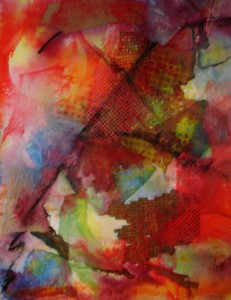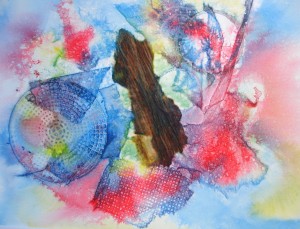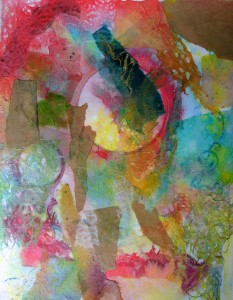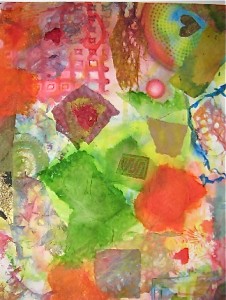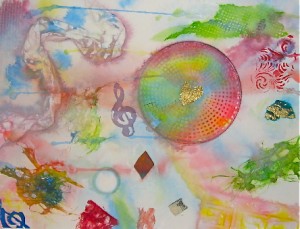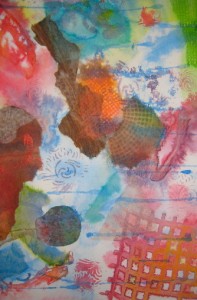Collaging with Kids, again – very fun. I managed to get a couple of videos in here for you along with some photos of the finished collages.
My friend Jody is genuinely generous and full of love. One example of this is what she’s doing right now – enjoying her 6-year old grandson, Zander. He lives in California. We live in South Carolina. She got on a plane a couple of weeks ago and went to California to pick him up. This kind of trip takes an entire day each way. In a couple of more weeks she will get on a plane with him and take him home. Then she will cry for about half the trip home and the rest of the trip she will be thinking of other generosities we, as her friends, will benefit from. If you don’t have a friend like this, drop everything and go seek one out. The best way I know to become loving and generous is to be in the presence of someone who treats you as if you already are.
Yesterday Jody and Zander and I played at collaging. I did things a little different this time. We collaged the paper first, and then we dripped the diluted acrylic ink. The reason for this change of order is that I noticed people have trouble covering up a painted paper with washi or other paper. They think they are destroying the Mona Lisa, rather than just creating a surface. For some people, this is the first time they’ve put any paint onto paper in many years and are so excited to see how interesting it looks.
What we did to get ready was to watch a DVD called “Return to the Ice Planet.” It’s about 10 minutes long and was written and created by my two grandsons. It’s a spoof on “Star Wars” and starts out as Episode 0. It was shot in their backyard, family room and the hills of Woodland Hills CA. It’s a fine example of brilliant kid humor and creativity. Zander loved it.
Then we got down to painting!
Step 1: We mixed a little glue and water onto a cardboard and then painted the glue mixture onto our paper where we planned to put the washi paper. Then we put down the washi paper and painted a very light coating of glue and water over it. We kept doing this until we had about 10 or 15 pieces of washi paper all connected to each other in some way – a corner or a side.
Step 2: We sprayed the entire paper with water until it was covered, but mostly around the non-collaged areas.
Step 3: With small squirt bottles of red, blue and yellow diluted acrylic ink, we dripped a little ink onto the paper and watched it run into the crevices of the washi paper and run around the watercolor paper. The more you squirt with water next to the ink you dropped, the more it moves. Usually at this point, we would let it dry for a few hours or overnight. But since there was nothing on there that would blow off, I used a hairdryer, mainly blowing onto the back of the painting. If you really want some interesting ink movement, let your piece dry naturally. Once the hair dryer hits it, the ink stops moving.
Step 4: Next we put three circular shapes onto our paintings. We used a metal ring, jar lids, embroidery hoops and a yogurt container. Then we squirted more ink around the edges. These we let dry overnight to be ironed in the morning.
We got in the mood this morning by watching the first episode of “Picasso” – a video that shows him using a marking pen on paper to create an image of him as the artist, painting a nude model. What’s so amazing about all of the episodes on this video is how much black he uses. He thinks in negative space, evidenced by the way he started the drawings.
Step 5: The final steps can be a variety of things: Ink an image over the interesting background (line on shape), paint around the shapes with watercolor pens and then squirt to make the paint run some more, or add more collage paper and then drip ink or draw.
Zander drew animals and faces and around some square shapes with watercolor pens, squirted a few and declared himself finished.
Jody put a few little dabs of watercolor onto her piece using the watercolor pens, squirted it a bit and decided she liked it the way it was. She did spend a lot of her painting time just enjoying Zander laughing and playing around with his piece.

